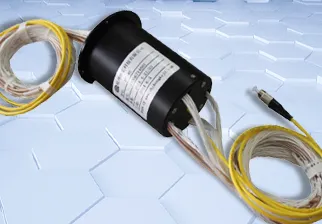Fiber optic rotary joints play a role in transmitting optical signals from a fixed platform to a rotating platform and are an essential component in many modern optical communication systems, but what are they used for? In this article, we explore the advantages and applications of fiber optic rotary joints, and why they are critical to optical communications.
Answering the Questions
What Is a Fiber Optic Rotary Joint (Forj)?
Fiber optic rotary joint (FORJ), also known as optical slip ring, is a precision optical device; capable of transmitting optical signals from a fixed platform to a rotating platform through a rotating interface, it can perform continuous, uninterrupted work.
How Does a Forj Work?
The smooth operation of a fiber optic rotary joint requires a stator and rotor connected by a fiber optic cable that allows light to pass through. Optical fiber swivel joints allow the transmission of optical signals without interruption or loss of signal.
What Are the Benefits of Using a Forj?
The primary benefit of using a FORJ is the ability to transmit optical signals across a rotating interface without interruption.
Highly Reliable: Can operate in harsh environments, making them ideal for many applications.
Improved Signal Quality: Fiber optic rotary joints provide superior signal quality compared to electrical slip rings. The use of fiber optics eliminates any electromagnetic interference, ensuring that the signal is transmitted without any degradation or loss.
Increased Bandwidth: Fiber optic rotary joints can handle much higher data rates than electrical slip rings. This is due to the high bandwidth capabilities of fiber optic cables, which can transmit large amounts of data quickly and reliably.
Longer Transmission Distances: Fiber optic rotary joints can transmit signals over long distances without any loss or degradation. This makes them ideal for use in applications that require long transmission distances, such as in industrial automation, robotics, and medical equipment.
Low Maintenance: Fiber optic rotary joints require minimal maintenance, which reduces downtime and maintenance costs. They are also less prone to wear and tear, which increases their lifespan and overall reliability.
What Are the Applications of Forjs?
*Military
*Aerospace
*Industrial Application
*Monitoring System
*Remotely Controlled Vehicle (ROV)
*Medical Equipment
*robot Technology
*Wind Turbine
*Oil and Gas Drilling Platforms
Are There Different Types of Forjs?
Yes, there are different types of FORJs, including single and multi-channel FORJs.
Single channel FORJ: designed to transmit a single optical signal;
Multi-channel FORJ: Simultaneous transmission of multiple optical signals;
Hybrid FORJ: can transmit optical signal and electrical signals.
Where Can I Find Forjs?
FORJ can be purchased from various suppliers such as Grand slip rings manufacturers.
What Are the Key Considerations When Selecting a Forj?
*Number of channels
*Wavelength range
*insertion loss
*Usage environment of FORJ
Conclusion
In conclusion, fiber optic rotary joints (FORJs) are crucial components in many modern optical communication systems. They allow for uninterrupted transmission of optical signals across a rotating interface, making them essential for applications in the military, aerospace, and industrial sectors. With their ability to operate reliably in harsh environments, FORJs provide critical data transmission capabilities for a wide range of applications.
Frequently Asked Questions
Q: What Is a Fiber Optic Rotary Joint (Forj)?
A: A fiber optic rotary joint (FORJ) is a device used to transmit optical signals from a stationary to a rotating platform.
Q: What Are Some Common Applications of Fiber Optic Rotary Joints?
A: *Aerospace
*Defense
*Medical
*Robotics
*Industrial Automation
Q: How Do Fiber Optic Rotary Joints Compare to Traditional Electrical Slip Rings?
A: Fiber optic rotary joints offer several advantages over traditional electrical slip rings, including improved signal quality, increased bandwidth, longer transmission distances, and low maintenance requirements.
Q: Can Fiber Optic Rotary Joints Transmit Both Data and Power Signals?
A: Yes, fiber optic rotary joints can transmit both data and power signals across a rotating interface. This makes them ideal for use in applications that require both power and data transmission.
See What We Can Do

